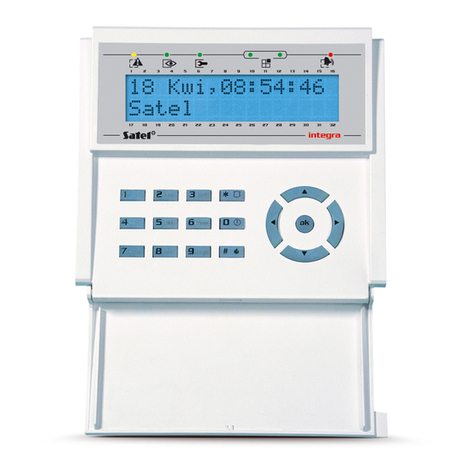2 GSM-X LTE SATEL
CONTENTS
1. Introduction........................................................................................................................4
2. Features ............................................................................................................................4
3. Typical module applications...............................................................................................7
3.1 Backup communication path .................................................................................................... 7
3.2 Supervision / control of devices................................................................................................ 7
3.3 Simulation of monitoring station ............................................................................................... 9
3.4 Work in conjunction with INTEGRA / INTEGRA Plus control panels ....................................... 9
3.5 Work in conjunction with STAM-2 monitoring station ............................................................. 11
3.6 Work in conjunction with PBX stations................................................................................... 11
3.7 Work within Internet of Things (IoT) ....................................................................................... 11
4. Description of the module................................................................................................12
4.1 Electronics board.................................................................................................................... 12
4.1.1 LED indicator.................................................................................................................................... 13
5. Installation .......................................................................................................................14
5.1 Preparing the cabling.............................................................................................................. 14
5.2 Installation of enclosure.......................................................................................................... 14
5.2.1 Elements inside the enclosure......................................................................................................... 15
5.3 Installation of antenna ............................................................................................................ 16
5.4 Connecting the analog telephone line .................................................................................... 16
5.5 Connecting the devices to the inputs and outputs.................................................................. 17
5.6 Connecting the RS-232 port................................................................................................... 17
5.7 Connecting the power supply and starting the module........................................................... 18
5.8 Connecting the computer to the module................................................................................. 18
5.9 Installing the SIM cards .......................................................................................................... 18
6. GSM-X-ETH Ethernet module .........................................................................................19
6.1 Electronic boards.................................................................................................................... 19
6.2 GSM-X-ETH module installation............................................................................................. 19
7. GSM-X-PSTN telephone module.....................................................................................20
7.1 Electronics board.................................................................................................................... 20
7.2 GSM-X-PSTN module installation.......................................................................................... 21
8. Programming...................................................................................................................22
8.1 Description of the GX Soft program........................................................................................ 22
8.1.1 Startup window................................................................................................................................. 23
8.1.2 Menu bar in the GX Soft program.................................................................................................... 24
8.1.3 Side menu........................................................................................................................................ 25
8.1.4 Status panel ..................................................................................................................................... 25
8.1.5 Additional menu................................................................................................................................ 26
8.2 Establishing connection between the program and the module............................................. 29
8.2.1 Local connection .............................................................................................................................. 29
8.2.2 Remote connection: SATEL server.................................................................................................. 29
8.2.3 Remote connection: Module > GX Soft............................................................................................ 30
8.3 Project .................................................................................................................................... 30
8.4 Hardware................................................................................................................................ 32
8.4.1 Mainboard ........................................................................................................................................ 32
8.4.2 GSM ................................................................................................................................................. 34
8.4.3 GSM-X-ETH/PSTN........................................................................................................................... 36
8.5 Inputs...................................................................................................................................... 37
8.5.1 Status............................................................................................................................................... 37
8.5.2 Settings ............................................................................................................................................ 38
8.5.3 Bypasses.......................................................................................................................................... 38
8.6 Outputs................................................................................................................................... 38
8.6.1 Control.............................................................................................................................................. 38
8.6.2 Settings ............................................................................................................................................ 38
8.6.3 Triggering......................................................................................................................................... 40
8.7 Communication....................................................................................................................... 40
8.7.1 SATEL server................................................................................................................................... 40
8.7.2 Direct connection to GX Soft............................................................................................................ 41




























